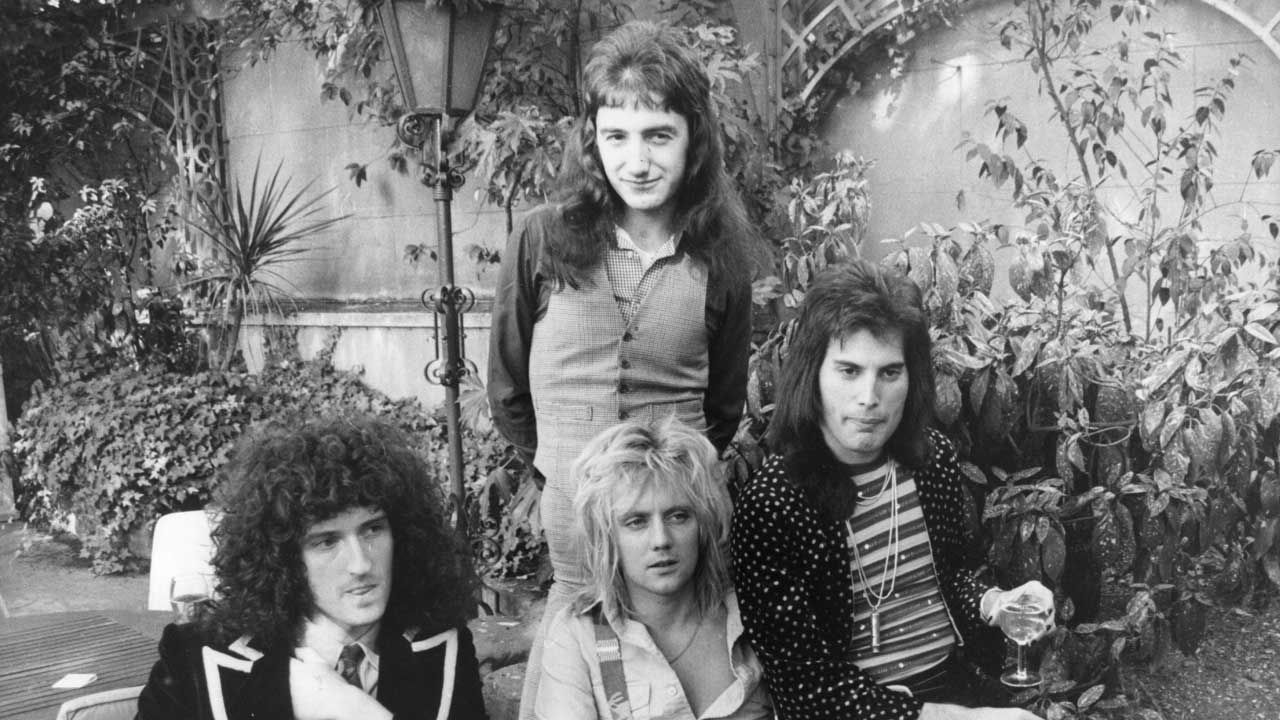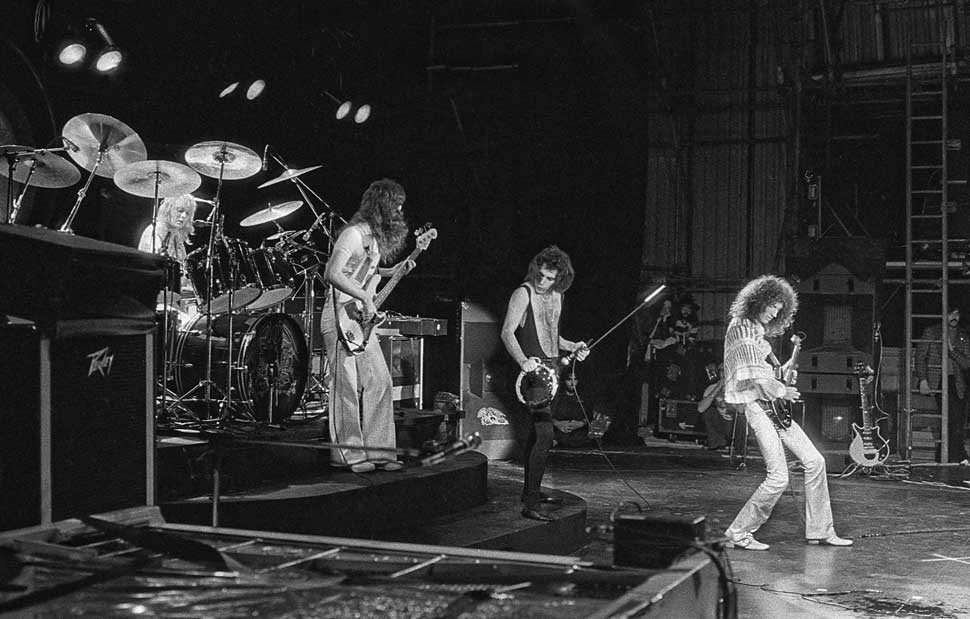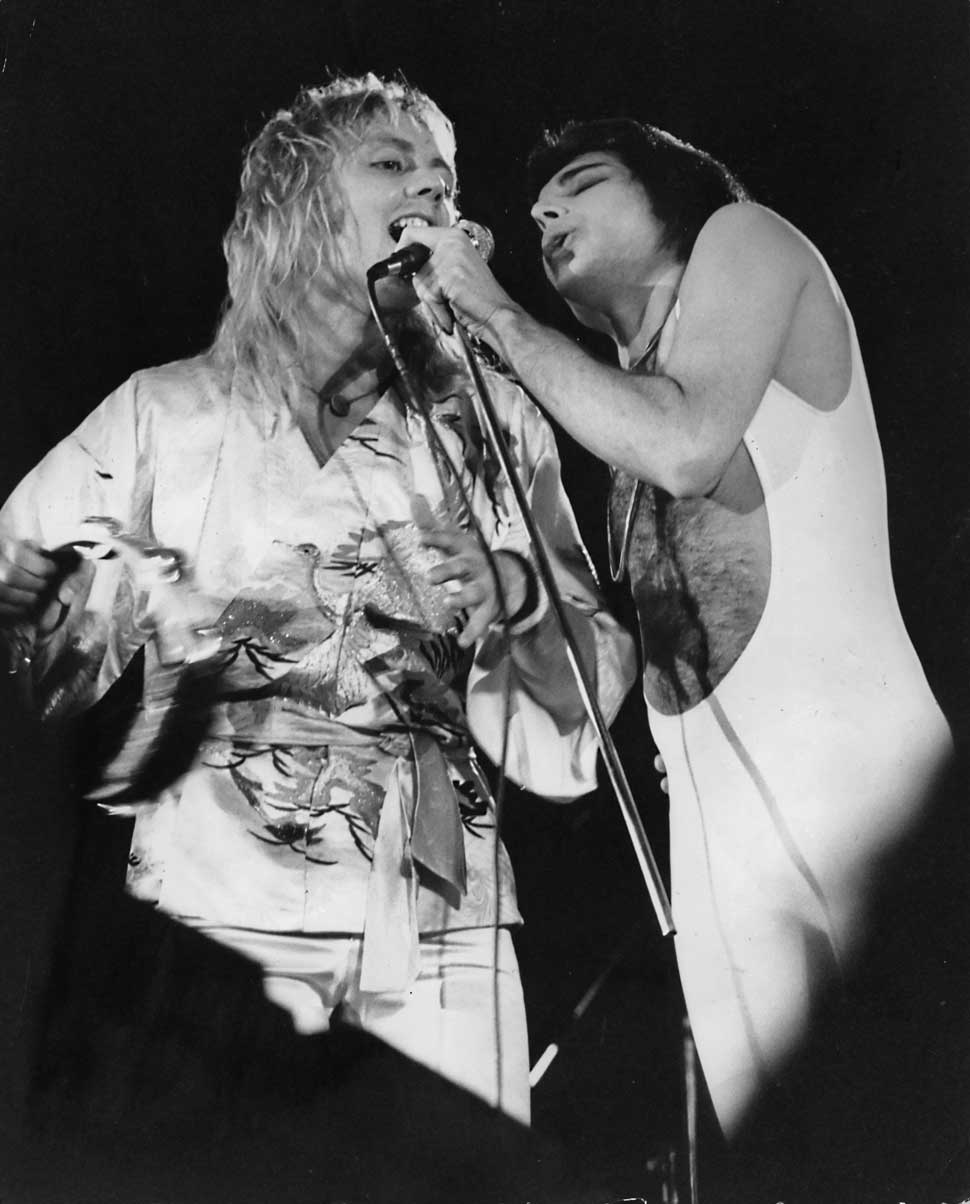
Summer 1976. Eight months after Bohemian Rhapsody tore up the rule book for hit singles, Queen have finally – finally – released a follow-up single, You’re My best Friend. It’s a lovely pop-rock ditty, infectious and in the groove and… what the fuck? That’s your follow-up to the most titanic rock song of all time?
Well, no. It would have to do for now, though, while Queen struggled fitfully to try to come up with the real follow-up to the squillion-selling album A Night At The Opera. The one they were bending over backwards in the studio pretending wouldn’t have anything to do with being a follow-up. The one they were pretending hadn’t changed a thing, but which in fact had changed everything.
Indeed, in the weeks leading up to the band going into the studio to start work on the new album, guitarist Brian May had married his girlfriend Christine Mullen at a church in Barnes, south London, and moved into a newly purchased semi nearby. Bassist John Deacon had bought a Victorian semi in Putney and moved in with his wife Veronica and their son Robert.
Drummer Roger Taylor, who was even richer, having accumulated extra royalties from having written and sung the B-side to Bohemian Rhapsody, the otherwise pedestrian I’m In Love With My Car, bought a smart house in upmarket Fulham, before also acquiring a country house in Surrey. Even singer Freddie Mercury was undergoing his own kind of love-home reinvention, splitting from his long-term, live-in girlfriend Mary Austin and moving into a luxury apartment in Holland Park, buying Mary a £30,000 flat nearby.
Now, in July, the band had entered The Manor studios in Oxfordshire to record a new album, with a late summer release anticipated. But things were not going well. Having decided against bringing in Roy Thomas Baker again to produce them, they undertook the task themselves, with Gary Langan and Mike Stone engineering. “Roy’s ego was exploding,” Langan later recalled laughingly.
Baker would still drop by occasionally to check on their progress, but Freddie Mercury, for one, was convinced that after four Thomas Baker-produced albums, “it was now or never” if Queen really were going to try for something new.
But with things moving much slower than they had under Baker, on some days Freddie flew into uncontrollable rages. When a UK tour planned to promote the release of the new album had to be postponed hastily, it hardly improved the pressured mood of the sessions.
To compensate, two huge outdoor shows were announced for September, the first at Cardiff Castle, the second in London’s Hyde Park. Two warm-up shows were also scheduled, both at Edinburgh Playhouse, a venue their manager John Reid now sponsored. First, though, on September 5, Mercury celebrated his 30th birthday with a typically over-the-top party at a cabaret club in Chelsea, where the 150-plus guests Freddie had sent personally handwritten invitations to were treated to caviar, lobster and Cristal champagne.
At the Cardiff show just five days later, support was supposed to come from the newly formed Ritchie Blackmore’s Rainbow, but the mercurial former Deep Purple guitarist had withdrawn the band from the bill at the eleventh hour after being refused permission to use their 35-foot stage prop of a rainbow.
Not that the Queen fans seemed to care. On stage the band premiered two of the new songs they’d been working on at The Manor. The first, Tie Your Mother Down, with its monster-clawing riff and teased-hair vocals, became an instant live classic and a mainstay of all Queen shows that followed. The second, You Take My Breath Away, was an unexpectedly transcendental moment, a breathy voice-and-piano ballad that found Freddie, for once, eschewing his usual more knowing approach to lyrics for a straight-out love song, albeit not one that was either straight or specifically focused on just one individual, more a dream within a dream.

For the show in Hyde Park on September 18, which was free, more than 150,000 people showed up. Support came from Kiki Dee, Steve Hillage (yes, this was the pre-punk 70s, kids) and, opening the bill, an unknown funk-rock outfit from Liverpool called Supercharge, whose guitarist Lee Karski had been at Ealing Art College with Freddie, back when he was still known as Fred Bulsara. Karski claimed he barely recognised Mercury when they met backstage: “He’d changed so much since those days.”
It wasn’t the happiest day for Freddie, though. Pre-show nerves led to a full-frontal outburst from him, aimed at all the backstage liggers, screaming at them to go and watch the show. Then at the end of Queen’s performance, police prevented the band from going back on stage for an encore, due to them having already overrun their allotted stage time by 30 minutes and thus broken the legally agreed curfew.
Again, Freddie’s temper boiled over in a fusillade of abuse, halted only when police officers threatened to arrest him. As Queen tour manager Gerry Stickles recalled: “The thought of being in jail in tights didn’t appeal to Freddie at all.”
Roger Taylor claimed Freddie’s outbursts were just another manifestation of Queen’s overweening ambition. “We always said we wanted to be the biggest band in the world,” he explained. “What else are you going to say? ‘We’d like to be the fourth-biggest!’”

Back in the studio, the band were determined to find the right balance between wanting to follow up A Night At The Opera and doing something completely new. “I thought it reeked of sequel,” Roy Thomas Baker famously said at the time of the album’s release.
That, though, was somewhat overstating the case. Nevertheless, Queen’s fifth album certainly ‘carried over’ from their fourth, right down to the appropriation of another Marx Brothers film, A Day At The Races, for its title. It also came wrapped in a very similar sleeve, including the same crest logo and typography used on A Night At The Opera. Years later, Brian May conceded the point, admitting: “I wish in some ways we’d put A Night At The Opera and A Day At The Races out at the same time. The material for both of them was written at the same time, so I regard the two albums as completely parallel.”
The big relief was that they didn’t try to ‘follow up’ the two most momentous tracks on A Night At The Opera – the six-minute single Bohemian Rhapsody and the eight-minutes-plus The Prophet’s Song. Both were self-contained epics, and anything purposely in that style would only ever have been seen as second-best.
Instead, A Day At The Races concentrated on pushing musical boundaries while keeping the focus firmly on mainstream messaging. The album’s two longest tracks – Mercury’s gloriously effete You Take My Breath Away and May’s winsome Teo Torriatte (Let Us Cling Together) – each barely broke five minutes. Deacon’s sole songwriting contribution, You And I, was so limp it made his spry hit You’re My Best Friend from Opera sound like Smoke On The Water. Similarly, Taylor’s one-song vocal and writer credit, Drowse, saw the drummer not so much in love with his car as sleeping it off in the back seat.
Fortunately, the good stuff on the album outweighed the drab. There was the aforementioned Tie Your Mother Down. Brian May had written the hooky guitar riff years before, while working a summer job at an observatory in Tenerife. The words were an afterthought.
“I thought it was a crap title,” he later confessed. “But Freddie said it meant something to him.” Indeed while May’s lyrics may have come across as typically misogynistic sub-Stones fodder, sung by a tongue-in-arse-cheek Freddie, it became an anthem to the kind of verboten Boy’s Own sex that only two acne-smeared teenage studs could fully comprehend.
Then there was the pop-rock apotheosis Good Old Fashioned Lover Boy, its pure Queen vocal harmonies and tippity-top use of ragtime jazz making Freddie’s paean to his then-boyfriend David Minns bounce like a lubed balloon.
More adventurous though equally joyous was the singer’s jaunty musical portrait of the band’s manager John Reid, The Millionaire’s Waltz. At Mercury’s behest, May spent weeks creating a swathe of orchestrated guitar sounds, which, coupled with the luxuriant bed of harmony vocals that had become the band’s trademark, propelled what began as a piano romp into a full-scale rocktastic workout, the kind that only Queen could have done so convincingly, and with such seemingly straight faces.
And of course there was rock with a capital ‘R’. The days of white queens and fairy kings may have been long gone for Queen, but that didn’t prevent Brian May from bringing out the lead when it suited him. The lyrics to White Man – a cry for justice on behalf of Native American Indians – may be horribly cringe-inducing to modern ears, but you could say that about the lyrics of almost every rock band from the same mid-70s period. Those mountainous guitars and drums, though, they do not lie.
The album’s finest moment, by far, of course, and one of the most transcendent moments in the history of rock, was Somebody To Love. At the time, it became characterised as this album’s Bohemian Rhapsody. That is, the pivotal track, its multi-layered harmony vocals and butterflying Mozartian piano the very essence of what had most intrigued the world about Bo Rap.
Yet it was different in so many ways. Those extravagant vocals, for example, weren’t conceived from opera, but from gospel. As John Deacon later explained, Somebody To Love proved that “Queen could swing as hard as it could rock, by channelling the spirit of gospel music”.
Specifically, that of Aretha Franklin and Ray Charles. Freddie had long adored Aretha. Every white rock musician worth his salted peanuts had long admired Brother Ray. Nevertheless, listening to Queen take on soul and gospel seemed like an even bigger stretch than them trying opera for size. But it worked. Oh, how it worked! A ‘throw in the kitchen sink’-sized epic that spoke of loneliness, love, God and devotion, with big piano chords, vigorous guitar flourishes and vocals that range from full voice to falsetto, it was also, as Roger Taylor later described it, “the loosest track we’ve ever done”.
That is, it may have been manicured in the studio to within an inch of its ultra-contrived life, yet somehow when sung and played out in the open, on stage or in the intimate cathedral of one’s own bedroom, Somebody To Love was one of the greatest self-actualising songs of the century.
As Brian May would later reveal: “That was part of Freddie’s great gift: to take a song and keep building it until it almost became something else. Until it belonged to everybody. Somebody To Love was like that.”
It certainly felt that way when it was released as the first single from A Day At The Races, racing to No.2 in the UK chart and gliding into the US Top 10. The album, released two weeks before Christmas 1976, enjoyed similar chart success. It was launched with a major blow-out afternoon of free-everything excess at Kempton Park racetrack. Eighty-six-year-old Groucho Marx sent them a congratulatory telegram: “I know that you are very successful recording artists. Could it, by any chance, be your sage choice of album titles?”
A Day At The Races became Queen’s second No.1 album in Britain, their first No.1 album in Japan, where the band now enjoyed Beatles-like stardom, and their second US top-five album.
It didn’t match the door-crashing-open success of its history-making predecessor, but it remains the most brilliantly realised non-followup follow-up ever. Critically it suffered, having arrived in the wake of first singles from the Sex Pistols and The Damned, being dismissed in the NME as “grotesquery of the first order”. But no one remembers that now. Instead, what we recall are the scope of Queen’s musical ambition, the utter cheek of Freddie Mercury’s proclamations, on stage and in the press, and the beautiful bombast and charm of the music of May, Deacon and Taylor.
And how things never really were quite the same again. Within a couple of years, everyone except May would have cut their hair, Freddie would be swapping the make-up for the beginnings of a cop-bar tash, and Queen would be pruning their music to a more punk-for-purpose size, or abandoning it completely to ‘go disco’. Even then we didn’t know half the story.
Right, Freddie? “You mustn’t look too closely at what we do,” he once announced grandly. “It will only make you go blind.”




!["[T]he First and Fifth Amendments Require ICE to Provide Information About the Whereabouts of a Detained Person"](https://images.inkl.com/s3/publisher/cover/212/reason-cover.png?w=600)


